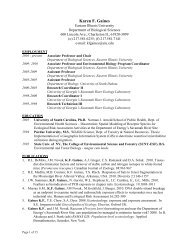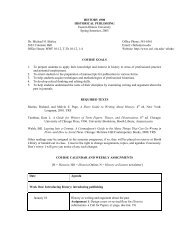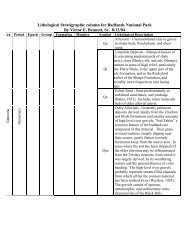Mariah Burton Nelson is a sports reporter and writer who has written extensively on sports and gender. Asa former Stanford <strong>University</strong> star athlete and professional basketball player, Nelson is highly critical of theunequal funding of men's and women's college sports programs, the issue addressed in this reading fromher controversial book, The Stronger Women Get, the More Men Love Football: Sexism and the AmericanCulture of Sports (1994). Her latest book is called Embracing Victory: How Women Can Compete Joyously,Compassionately, and Successfully in the Workplace and on the Playing Field (1999).As you read this excerpt from The Stronger Women Get, the More Men Love Football, which wehave titled "Adventures in Equality" after the cartoon from her book, notice how Nelson uses the journalisticconvention of quoting people and presenting information without specifying her sources. For college essays,however, readers expect every source to be cited consistently.6Adventures in EqualityMaria Burton NelsonIn the early 1990% as female athletes and coaches sued dozens of universities for equal opportunities andas judges consistently ruled in favor of the women, football coaches and administrators waged what onewoman called "an offensive" against athletic feminists, claiming that women were attacking the sacredfootball cow.Women weren't, in fact, attacking football. They just wanted to swim, row, play soccer, play tennis, orgolf, and to coach and direct programs, as men do. They just wanted equal salaries, uniforms, travelschedules, scholarships, and facilities.In fact, football—or, rather, male support of football and lack of support of women's sports—isresponsible for much of the disparity between male and female college sports opportunities. Football"requires" oodles of athletes (108, on average, in Division I), scores of scholarships (75, on average),excessive coaching salaries ($81,574 is the average "base"), and exorbitant operating expenses (more thanfor all other women's and men's sports combined).Inevitably, if women are to have half of all sports allocations, as they are entitled to by law, footballwill have to change. Some schools will trim football's bloated budgets. Others will drop football altogether, asthe <strong>University</strong> of Wisconsin, Superior; Wichita State; the <strong>University</strong> of Southern Colorado; and Northeastern<strong>Illinois</strong> <strong>University</strong> have already done. Others will leave football alone and add several large-squad women'ssports, market women's programs to increase revenue, or find other creative ways to stop discriminating. Butfootball defenders fear that their glory days are limited, and they blame women."What I'm afraid of is that somebody is trying to put a bull's eye on football's chest," said OregonAthletic Director Bill Byrne, former president of the National Association of Collegiate Directors of Athletics. 1The Reverend Edmund P. Joyce, former executive vice-president at the <strong>University</strong> of Notre Dame,accused "militant women" of waging a "strident, irresponsible, and irrational campaign" against football."Never have our football programs been in such jeopardy as they are today," Joyce said. "I think we arefighting for our lives and had better act accordingly." 2The fight for college football's life includes arguing that football is the cash cow upon which all thewomen's programs suckle, even though this is a lie. "Revenue producing"—a term often used to justifydiscriminatory football and men's basketball programs is not synonymous with "profit producing." Footballprograms that earn money almost always spend more—not on women's sports, but on football. In 91 percentof all colleges, the football program does not make enough money to pay for itself. 3 Even in the big, footballdominateduniversities (Division I-A), 45 percent of the football programs lose money. In the other threedivisions (I-AA, 11, and Ill), between 94 and 99 percent of the schools lose money on football. 4
Besides, judges have ruled that "financial considerations cannot justify gender discrimination."The fight for football's life includes arguing that football should be exempt from gender-discriminationcalculations. Thomas Hearn, president of Wake Forest <strong>University</strong>, defended his school to RepresentativeCardiss Collins of <strong>Illinois</strong> during a congressional hearing by saying, "At Wake Forest, our athletic scholarshipawards without football would approach parity, with 60 percent going to men and 40 percent to women."<strong>University</strong> of New Haven football coach Mark Whipple has said, "Football shouldn't have anything to do withgender equity. If you don't count football, I think everyone would be happy." 5"I don't think football players are a third sex," Women's Sports Foundation executive director DonnaLopiano responded. The courts have agreed.The fight for football's life includes arguing that women are being unAmerican, even communist, bydepriving young men of their right to play football. Auburn <strong>University</strong> football coach Pat Dye has said, '70 tella kid he can't come out for college football as a walk-on because it creates a numbers problem with thewomen in another area, I mean that's almost like communism. That (isn't) what this country was built on, orwhat it stands for." 6<strong>University</strong> of Iowa women's athletic director Christine Grant's response: 'Schools have had twentyyears to think about this. It's unfortunate for the young men who get cut, but it's even more unfortunate forthe millions of young women who have missed out for 100 years." 7The fight for football's life includes redefining "gender equity" to mean men get 60 percent, womenget 40 percent. In what was hailed as a bold move, the Big Ten Conference recently approved a "genderequity" plan requiring 40 percent of its athletes to be women by 1997. Only the <strong>University</strong> of Iowa committeditself to a 50-50 split, which will make it the only Big Ten school to comply, finally, with the 1972 law.The fight for football's life includes arguing that "progress" toward Title IX compliance is being made.In fact, if athletic directors had wanted to end discrimination during the wealthy eighties, they could haveadded women's programs while holding men's programs steady. Instead, over the ten-year period betweenthe 1981-1982 season and the 1991-1992 season, for every two female participation slots created, 1.5 maleslots were created. 8Representative Cardiss Collins has introduced a House bill called the "Equity in Athletics DisclosureAct" that would require school administrators to disclose participation rates and expenditures for male andfemale athletes. Football coaches and male athletic directors testified against the bill.The fight for football's life includes contending that few women want to play sports. This is a lastditcheffort to deny women their rights based on a Title IX interpretation that allows unequal allocations if "theprogram fully and effectively accommodates the interests and abilities" of both sexes. Big Ten CommissionerJim Delaney told me, "Not as many women are interested in playing sports as men. Look at field hockeyversus football. Hundreds of men go out for football. It carries more status."Collins's response: "Lower participation rates are the result of discrimination, and 1, not an excusefor continued inequities." 9At the Division I-A level, only one out of 107 schools complies with Title IX. This is 15 WashingtonState <strong>University</strong> (WSU), which was forced to do so by its own Supreme Court. In response to a class actionsuit filed by fifty-three female coaches and players, a judge ruled in 1982 that the number of WSUscholarships must be proportional to the ratio of women and men in the undergraduate student body.However, he exempted football from the count. But in 1987, the Supreme Court of Washington overruled thefootball exemption. The number of female athletes at WSU is now 44 percent, up from 29 percent in 1987.The female undergraduate student population is 46 percent."We were dragged kicking and screaming into the forefront," recalls Harold C. Gibson, 20Washington State's associate athletic director. People "thought the sky was falling." 10They still seem to think so. The College Football Association's Charles Neinas recently launched apublic relations campaign with the slogan, "College football: More than just a game." 11In a surprisingly frank speech to his fellow football coaches and athletic directors, Neinas said,"Football may be the last bastion of male domination." 12Which explains a lot.Notes1. Ben Brown, “Law Gives Women Their Fair Share," USA Today, 9 June 1992, p. C1.2. Buck Turnbull, "Notre Dame's Joyce Says Future of Game on Line vs. Militant Women," USAToday 7 June 1993, p. 12C.7
















